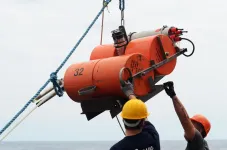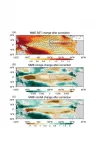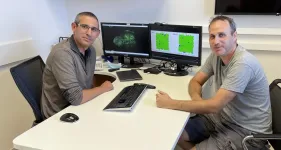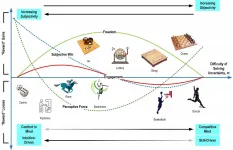When conservation work pays off: After 20 years, the Saker Falcon breeds again in Bulgaria
2021-05-11
(Press-News.org) The Saker Falcon (Falco cherrug) is a bird of prey living in plains and forest-steppes in the West and semi-desert montane plateaus and cliffs in the East. The majority of its Central and Eastern European population is migratory and spends winters in the Mediterranean, the Near East and East Africa. With its global population estimated at 6,100-14,900 breeding pairs, the species is considered endangered according to the IUCN Red List.
In Bulgaria, the Saker Falcon, considered extinct as a breeding species since the early 2000s, was recovered in 2018 with the discovery of the first active nest from its new history in Bulgaria. The nest is built by two birds that were reintroduced back in 2015 as part of the first ever Saker Falcon reintroduction programme. The results of the 5-year programme are described in detail in the open-access, peer-reviewed Biodiversity Data Journal.
Many factors contributed to the decline of the Saker Falcon in Bulgaria and globally, and most of them are human-caused. Populations lost big parts of their habitat due to changes in land use - the transition from grazing to arable crops led to the diminishing of key food sources. Other reasons include the use of poisonous baits and the accumulation of pesticides in the food chain, illegal trade of nest-poached chicks and eggs, power line electrocution, and lack of suitable nesting places.
Even after European legislation for the protection of wildlife was implemented, and regulations were issued on the use of pesticides in Bulgaria, the Saker Falcon population did not stabilise. Its endangered status further prompted joint conservation efforts between NGOs and national authorities.
As a result, a re-introduction programme for the Saker Falcon in Bulgaria was initiated in 2015, aiming to release a number of birds over a certain period of time using adaptation aviaries, or hacks. The Green Balkans Wildlife Rehabilitation and Breeding Centre (WRBC) in Stara Zagora facilitated the captive breeding of a group of Saker Falcons imported from Austria, Hungary, Germany, Slovakia and Poland by constructing ten breeding aviaries and two stock cages for juvenile falcons and equipping them with internal surveillance cameras.
Between 2015 and 2020, a total of 80 Saker Falcons - 27 females and 53 males, were released via the hacking method from four aviaries near the town of Stara Zagora. Out of them, 64 had been bred and hatched at the WRBC.
Observation records from 2018 confirmed that at least one pair of the falcons released in 2015 was currently breeding in the wild in Bulgaria. This observation proves that with the help of hacking, Sakers can survive in the wild until maturity, return to the region of their release and breed successfully. In 2020, the female bird in the breeding pair was changed with a Saker Falcon released in 2016, and the new pair bred successfully.
In 2020, the programme was restarted for another 5 years, with the aim to release 100 Saker Falcons and have six pairs breeding in the wild. This will help restore the Saker Falcon population in the southern Balkans and facilitate gene flow amongst fragmented populations from Central Europe to Kazakhstan.
Helping this iconic species successfully establish a self-sustaining population in Bulgaria has profound implications for conservation in the country - not only in terms of public awareness of species conservation, but also as an indicator of wider environmental issues.
INFORMATION:
Original source:
Lazarova I, Petrov R, Andonova Y, Klisurov I, Dixon A (2021) Re-introduction of the Saker Falcon (Falco cherrug) in Bulgaria - preliminary results from the ongoing establishment phase by 2020. Biodiversity Data Journal 9: e63729. https://doi.org/10.3897/BDJ.9.e63729
ELSE PRESS RELEASES FROM THIS DATE:
2021-05-11
Northern Chile is an ideal natural laboratory to study the origin of earthquakes. Here, the Pacific Nazca plate slides underneath the South American continental plate with a speed of about 65 millimetres per year. This process, known as subduction, creates strain between the two plates and scientists thus expected a mega-earthquake here sooner or later, like the last one in 1877. But although northern Chile is one of the focal points of global earthquake research, until now there was no comprehensive data set on the structure of the marine subsurface - until nature itself stepped in to help.
On 1 April 2014, a segment of the subduction zone ...
2021-05-11
St. Petersburg, like other cities in the Russian Federation, is actively participating in the establishment of the "Smart City" program, which will provide new services for residents of the megalopolis, increasing the safety of citizens. Digital services are essential for such a system.
Due to the Internet of Things (IoT) systems, the environment can adapt to the needs of humanity on its own accord. Cybersecurity threats are especially dangerous for such infrastructure.
Specialists from Peter the Great St.Petersburg Polytechnic University (SPbPU) developed the methodology for assessing cyber risks in intelligent systems of a Smart City. The developed methodology was tested on the "smart crossroads" ...
2021-05-11
A reliable projection of extreme El Niño frequency change in future warmer climate is critical to managing socio-economic activities and human health, strategic policy decisions, environmental and ecosystem managements, and disaster mitigations in many parts of the world. Unfortunately, long-standing common biases in CMIP5 models, despite enormous efforts on the numerical model development over the past decades, make it hard to achieve a reliable projection of the extreme El Niño frequency change in the future. While increasing attentions have been paid to estimate possible impacts of models' biases, it is not yet fully understood whether and how much models' common biases would impact the projection ...
2021-05-11
Using Zebrafish, researchers from the School of Neurobiology, Biochemistry and Biophysics at the Faculty of Life Sciences of Tel Aviv University have developed an advanced simulation of a key process in the brain - the activation of the stem cells responsible for generating neurons. The simulation revealed that the process, which until today was considered to be random, is in fact coordinated, thereby ensuring the normal production of neurons in the brain. According to the researchers, their findings add another layer of understanding to brain development, ...
2021-05-11
Ishikawa, Japan - History tells us that games are an inseparable facet of humanity, and mainly for good reasons. Advocates of video games laud their pros: they help develop problem-solving skills, socialize, relieve stress, and exercise the mind and body--all at the same time! However, games also have a dark side: the potential for addiction. The explosive growth of the video game industry has spawned all sorts of games targeting different groups of people. This includes digital adaptations of popular board games like chess, but also extends to gambling-type games like online casinos and betting on ...
2021-05-11
According to the British Heart Foundation, heart and circulatory diseases cause more than a quarter (27 per cent) of all deaths in the UK, which equates to more than 160,000 deaths each year - or one death every three minutes.
The research, published in the top science journal Advanced Science, found that injection of the trace mineral manganese could enhanced MRI scans so that they provided more accurate details of heart function than traditional MRI methods.
These findings, if confirmed in human subjects, could have major implications for the treatment of heart attack patients. The findings could also be of great use in the preclinical evaluation of treatments for patients who suffer from cardiac ischemia - a reduction in blood supply ...
2021-05-11
By combining two medications, researchers at Michigan Medicine optimized a therapy for people with gout, a condition that causes severe damage and disability if left untreated.
The study revealed how a second drug taken orally more than doubled the effectiveness of Pegloticase, an intravenous gout treatment used to dissolve crystalized uric acid in the joints when oral medications fail.
"Gout is a challenging disease to treat because there are only a handful of oral therapies to lower uric acid," says Puja Khanna, M.D., M.P.H., a rheumatologist at Michigan Medicine. "Now, we have a medication that works and gives us a ...
2021-05-11
New guidelines for coral reef restoration aiming to reduce the risk of flooding in tropical coastal communities have been set out in a new study that simulated the behavior of ocean waves travelling over and beyond a range of coral reef structures. Published in Frontiers in Marine Science, these guidelines hope to optimize restoration efforts not only for the benefit of the ecosystem, but also to protect the coast and people living on it.
"Our research reveals that shallow, energetic areas such as the upper fore reef and middle reef flat, typically characterized by physically-robust coral species, should be targeted for restoration to reduce coastal flooding," says Floortje Roelvink, lead author on the paper and researcher at Deltares, a Dutch research ...
2021-05-11
Obsessive-compulsive disorder (OCD) in children and adolescents is associated with impaired education and worse general health later in life. Access to specialist treatment is often limited. According to a study from Centre for Psychiatry Research at Karolinska Institutet in Sweden and Region Stockholm, internet-delivered cognitive behavioural therapy (CBT) can be as effective as conventional CBT. The study, published in the prestigious journal JAMA, can help make treatment for OCD more widely accessible.
Obsessive-compulsive disorder (OCD) is a potentially serious mental disorder that normally debuts in childhood.
Symptoms include intrusive thoughts that trigger anxiety ...
2021-05-11
Toxicity and Challenges in Transferability of Surface-functionalized Metallic Nanoparticles
https://doi.org/10.15212/bioi-2020-0047
Announcing a new article publication for BIO Integration journal. In this review the authors Muhammad Arif Asghar, Rabia Ismail Yousuf, Muhammad Harris Shoaib, Muhammad Arif Asghar and Nazish Mumtaz from Jinnah Sindh Medical University, Karachi, Pakistan, University of Karachi, Karachi, Pakistan, Food and Marine Resources Research Centre, Pakistan and Benazir Bhutto Shaheed University, Karachi, Pakistan discuss toxicity and challenges in transferability of surface-functionalized metallic nanoparticles from animal models to humans.
The unique size and surface morphology of nanoparticles ...
LAST 30 PRESS RELEASES:
[Press-News.org] When conservation work pays off: After 20 years, the Saker Falcon breeds again in Bulgaria






